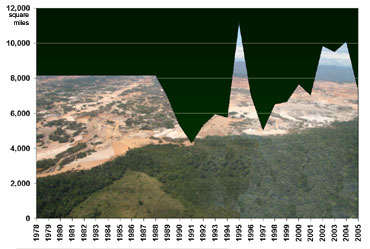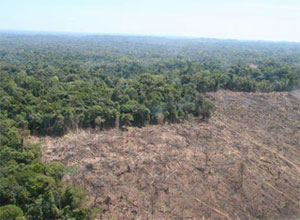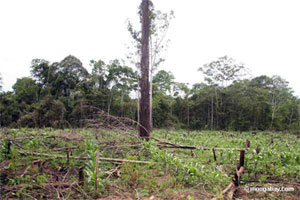Amazon deforestation slows in Brazil for 2005
Rhett A. Butler, mongabay.com
December 5, 2005 [2006: Amazon deforestation rate plunges 41 percent]
Deforestation in the Amazon rainforest fell 37% for the 2004-2005 year according to Brazilian government figures released today. Between July 2004 and August 2005, 7,298 square miles of rainforest (18,900 square kilometers) — an area almost half the size of Switzerland — were destroyed. Last year the figure was 10,088 square miles (26,129 sq km kilometers) and since 1978 some 211,180 square miles (546,905 sq km) of forest has been lost.
Deforestation in the Brazilian Amazon is largely due to land conversion for agriculture and cattle pasture. Logging also plays and important role in forest degradation and loss.
The Brazilian government has tried to take credit for the drop in deforestation, but analysts say the slowing is more likely due to lower commodity prices, giving farmers less incentive to clear forest land. The recent outbreak of foot-and-mouth disease in Mato Grosso do Sul, has also probably had an impact on forest clearing for cattle grazing.
Prior to the outbreak of foot-and-mouth, Brazil was experiencing record beef exports. According to figures released by the Brazilian Confederation of Agriculture, over the 12-month period from August 2004 to July 2005, revenues from Brazilian beef exports totaled US$ 2.896 billion, 41% more than the US$ 2.057 billion registered between August 2003 and July 2004. Volume during this period went from 1.539 million tons exported between August 2003 and July 2004 to 2.188 million tons (August 2004 to July 2005). Russia , Egypt (US$ 159 million), Britain, Venezuela, and the United States are major markets for Brazilian beef. While clearing for cattle pasture is widely cited as a major force behind deforestation in the Amazon, much of Brazil’s beef production actually occurs outside rainforest regions. Within the rainforest, forest-clearing for pasture is more of a strategy for acquiring title to land than for large-scale cattle production.
A soy explosion
 |
|||||||||||||||||||||||||||||||||||||||||||||||||||||||||||||||||||||||
|
|||||||||||||||||||||||||||||||||||||||||||||||||||||||||||||||||||||||
Deforestation in the Amazon, as well as in the nearby cerrado grassland ecosystem, is also lately driven by soybean cultivation. Today soybeans are flourishing — since 1998, Brazil has added 30 million acres of soybeans and American firms are aggressively expanding their presence in the Brazilian agricultural sector. Brazil will likely soon supplant the United States as the world’s leading exporter of soybeans.
The growth of agriculture in the Amazon has necessitated the improvement of roads and highways in the region. The Brazilian and Peruvian governments are currently paving a road that leads from the heart of the Amazon to ports in Peru. Scheduled to be completed by June 2006, the road has already spurred deforestation by settlers seeking lands for subsistence agriculture.
Logging — the obscured threat
Logging is a major force behind Amazon rainforest loss and degradation. An October 2005 study by the Carnegie Institution’s Department of Global Ecology found that due to “selective” logging, Brazil’s Amazon rainforest is being degraded twice as fast as overall deforestation figures suggest. Researchers looked at data from three NASA satellites — Landsat 7, Terra and Earth Observing 1 — for five Brazilian states between 1999 and 2002 and determined that conventional analysis of satellite data detects only about half the damage caused by timber harvesting by missing degradation that occurs beneath the rainforest’s protective canopy. After devising a new method for analyzing the data, the researchers found that selective logging is highly damaging, creating an additional 60 to 123 percent more damage than deforestation alone while resulting in 25 percent more greenhouse gas emissions than previously believed. Further, selective logging dries out the forest interior increasing the risk of forest fires which spread from nearby agricultural fields. Selective logging has also been correlated to road construction which typically triggers additional deforestation as well as wildlife hunting by timber workers.
Marred by violence
The movement poor settlers into the Amazon region has produced violent conflicts over land rights with existing landowners. The Pastoral Land Commission, a nongovernmental group working in the region, found that land battles in Brazil’s countryside reached the highest level in at least 20 years in 2004. According to the annual report by the organization, documented conflicts over land among peasants, farmers and land speculators rose to 1,801 in 2004 from 1,690 conflicts in 2003 and 925 recorded in 2002. Tensions reach their peak earlier this year with the high profile slaying of Dorothy Stang, an American nun who worked with rural poor, by gunmen associated with plantation owners. In response to the murder, the Brazilian government sent in the army to quell violence in the region and promised to step up environmental monitoring efforts.
Still some locals view the government’s increased presence in the area as an ominous sign of things to come. According to a June 23 article in Los Angeles Times, many Brazilians are “convinced that foreign powers, in particular the United States, are making plans for a takeover of the world’s biggest tropical forest to secure the rights to its seemingly limitless natural resources.” 75% of Brazilians surveyed in a recent poll said they feared a foreign invasion provoked by their country’s natural riches. Environmentalists’ interests in the Amazon are seen as a way for foreigners to assert control over the region.
 Amazon clear-cutting |
Environmentalists maintain that their intentions in the region are purely altruistic and based on the premise that the Amazon houses as much as 30% of the world’s biodiversity and provides critical local and global ecological services. Scientists say the Amazon forest plays a key role in the global environment, supplying a portion of the world’s oxygen and locking up massive amounts of carbon. As forest is cut, carbon dioxide is released into the atmosphere contributing to the accumulation of greenhouse gases in the atmosphere. Further, scientists have found that the reduction of forest cover has affected local weather patterns. Less rain tends to fall in deforested areas and scientists fear that continued forest clearing could turn much of the region into savanna. A recent study in Science warned that a prolonged drought in the Amazon could lead to a massive die-off in the world’s largest rainforest.
Home to up to 30 percent of the world’s plant and animal species, including a new species of monkey discovered earlier this year, the Amazon is said to hold a great deal of promise in the development of drugs and other useful products derived from its biodiversity. Through bioprospecting this economic potential is increasingly being realized and a number of pharmaceutical products have been derived from plants in the region. Indigenous populations have rational uses for thousands more.
Climate change may increase value
 Amazon slash-and-burn |
Brazil’s rainforests may become increasingly valuable as industrialized countries look for ways to mitigate greenhouse gas emissions. At the current United Nations Framework Convention on Climate Change conference in Montreal, a group of rainforest countries have proposed a plan whereby wealthy countries would pay them to preserve their rainforests and the services these ecosystems provide. While the proposal only involves ten countries at the moment, Brazil could stand to gain from a carbon trading scheme since it has the greatest capacity to store carbon in its forests, most of which are tropical and have a greater capacity to counter global warming than temperate forests. At current prices of $20 a ton, Brazil’s forests are worth $2.1 trillion in carbon storage alone. However, Brazil could be challenged by an agreement that penalizes countries for carbon released through deforestation since leads the world in total forest loss and is responsible for the bulk of land-change related greenhouse gas emissions.
Regardless of what happens in Montreal, Brazil’s Amazon rainforest will continue to play an important role in its economic development and the world environment.